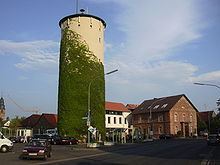Admin. region Unterfranken Elevation 110 m (360 ft) Area 10.63 km² Local time Friday 6:36 PM | Time zone CET/CEST (UTC+1/+2) Population 7,258 (31 Dec 2008) Postal code 63796 | |
 | ||
Weather 12°C, Wind W at 11 km/h, 57% Humidity | ||
Kahl am Main (officially Kahl a.Main) is a community in the Aschaffenburg district in the Regierungsbezirk of Lower Franconia (Unterfranken) in Bavaria, Germany.
Contents
- Map of Kahl am Main Germany
- Location
- Population development
- Community council
- Coat of arms
- Town partnerships
- Clubs
- Buildings
- Parks
- Nature
- Transport
- Nuclear power station
- Established businesses
- References
Map of Kahl am Main, Germany
Location
Kahl am Main lies 107 m above sea level and includes at the mouth of the river Kahl the lowest point in Bavaria. It also lies right on the boundary with Hesse in a favourable location with regards to transport between Aschaffenburg and Hanau (Main-Kinzig-Kreis).
Population development
Kahl’s population growth is between −0.1% and 0.1%.
Community council
The council is made up of 21 council members, counting the mayor.
(as at municipal election held on 2 March 2008)
Coat of arms
The community’s arms might be described thus: Party per bend sinister wavy, the parting surmounted by a bend sinister wavy argent, azure a coney courant of the first in bend sinister, gules a demi-wheel spoked of six of the first couped in bend sinister.
The community of Kahl lies on a bow in the river Main, and this is referenced by the bend sinister wavy (slanted wavy stripe) in the arms. This also refers to the river Kahl, which is part of the community’s name. The tinctures argent and gules (silver and red) and the half-wheel refer to Electoral Mainz’s former overlordship in the community. The silver hare recalls the Kahl dwellers’ nickname Sandhasen (“Sand Hares”) – sometimes also Sandbauern (“Sand Farmers”) – arising from the community’s lower crop yields than in other Main communities due to the sandy soil. Since 1806 the place has belonged to Bavaria, which is reflected in the tinctures argent and azure (blue).
The arms have been borne since 19 July 1960.
Town partnerships
The last-named relationship is a “town friendship”.
Clubs
An extensive offering through local clubs gives young and old the opportunity to engage in the most varied forms of leisure activities, from church groups to music and singing clubs to sport clubs and aid organizations such as the Feuerwehr FF-Kahl (fire brigade) and the Rotes Kreuz Kahl. There is an umbrella group, the Vereinsgemeinschaft Kahl (“Kahl Club Community”), to which many of the local clubs belong, and which, among other things, stages the yearly Kerb.
Buildings
Parks
Nature
The local scenery is characterized by forest and water, which make up 75% of the municipal area. The quarry lakes of the Kahl Lake Plateau (Kahler Seenplatte) with outdoor bathing at Waldseebad (former Emma-Nord stripmine) and Campingsee (Freigericht-Ost) with one of Bavaria’s biggest campsites as well as the angling ponds of the former Emma-Süd pit and the Vorspessartseen (lakes) offer opportunities for angling, boating, swimming and surfing. Five hiking trails and a fitness course (Vitaparcours) lead through the Kahl nature areas with their typical vegetation and sand flora. Many wild herbs, hogweed, wild carrot and malva grow in the meadows alongside the Main, where there is also a small campsite.
The natural monument Hexeneiche (“Witches’ Oak”) on the B 8 was destroyed on 7 August 1970 by a lightning strike. The oak, known to have already been standing in the Thirty Years' War, had to be felled on 8 June 1971. A newly planted oak and a memorial stone recall the witchhunts in the early 17th century, to which 69 women and 21 men fell victim here.
On holidays, especially when two fall one after the other, the railway line between Kahl am Main and Schöllkrippen is often used for “Historic Steam Locomotive Journeys”
In Kahl begins the Kahltal-Spessart cycling-hiking trail.
Transport
Kahl am Main lies in a favourable location with regards to transport between Aschaffenburg and Hanau with good transport links to Autobahn A 45 (Gießen - Aschaffenburg) as well as Autobahn A 3 (Frankfurt am Main - Würzburg - Nuremberg - Munich). Bundesstraßen 8 (Aschaffenburg - Hanau), 43 and 43A link Kahl am Main to the Frankfurt Rhine Main Region.
The Main–Spessart railway from Frankfurt to Würzburg, where it connects to Nuremberg and Munich, runs through the Kahl am Main station, which is served by Regional-Express services. Here the Kahlgrundbahn (to Schöllkrippen) branches off. Kahl has no goods station. The nearest ones are in Hanau and Aschaffenburg.
The nearest airport is Frankfurt Airport.
Nuclear power station
Despite the name, the first nuclear reactor in Germany, the "Versuchsatomkraftwerk Kahl" (“Kahl Experimental Nuclear Power Station”) was not built in Kahl am Main but in the neighbouring municipality of Großwelzheim (now part of Karlstein am Main). There were three reasons the plant was not named after Großwelzheim:
The power plant was shut down in 1985 and the reactors have been dismantled.
Established businesses
Within Kahl’s municipal limits, roughly 350 businesses have their seats, among them Kopp (500 employees), Linde Material Handling GmbH (550 employees) and Singulus Technologies (350 employees), three big companies in engine building and electronics. Business taxes from all businesses lie between €3,300,000 and €9,100,000 each year.
